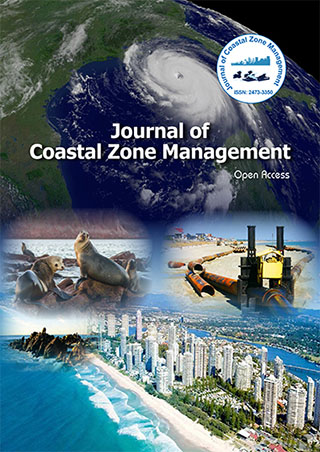Indexed In
- SafetyLit
- RefSeek
- Hamdard University
- EBSCO A-Z
- OCLC- WorldCat
- Publons
Useful Links
Share This Page
Journal Flyer

Open Access Journals
- Agri and Aquaculture
- Biochemistry
- Bioinformatics & Systems Biology
- Business & Management
- Chemistry
- Clinical Sciences
- Engineering
- Food & Nutrition
- General Science
- Genetics & Molecular Biology
- Immunology & Microbiology
- Medical Sciences
- Neuroscience & Psychology
- Nursing & Health Care
- Pharmaceutical Sciences
Opinion Article - (2022) Volume 25, Issue 10
Coastal Engineering's Objectives and Responsibilities
Reeven Puleo*Received: 04-Oct-2022, Manuscript No. JCZM-22-18646; Editor assigned: 06-Oct-2022, Pre QC No. JCZM-22-18646 (PQ); Reviewed: 21-Oct-2022, QC No. JCZM-22-18646; Revised: 31-Oct-2022, Manuscript No. JCZM-22-18646 (R); Published: 08-Nov-2022, DOI: 10.35248/2473-3350.22.25.526
Description
Coastal engineering is a branch of civil engineering that is in charge of organising, conceptualising, creating, and maintaining coastline projects. The goals of these duties include controlling coastline erosion, enhancing harbours and navigational channels, defending against flooding brought on by storms, tides, and even seismically driven waves (tsunamis), enhancing coastal recreation, and controlling pollution in neighbouring marine habitats. Typically, coastal engineering involves the construction of structures as well as the movement and potential stability of beach sand and other coastal sediments.
Essentially, the term "coastal engineering" refers to the use of abilities, information, know-how, and theoretical concepts related to deliberate technical intervention in the coastal system. This definition covers the application of scientific principles to a wide range of conventional engineering disciplines to an area where there are significant interactions between water and land, such as shorelines, bays, lakes, estuaries, inlets, river mouths, and harbours, as well as the structures within these environments. In order to manage erosion, place, construct, and monitor coastal structures, replenish beaches, and establish and maintain ports, harbours, and related navigation infrastructure, coastal engineering uses the practise of civil engineering as well as the disciplines of oceanography and coastal geology.
As wetlands and water quality take on more significance, the function of the coastal engineer is increasingly broadening to include environmental and ecological concerns. In regions where previous coastal engineering methods have had negative effects, there are also prospects for environmental repair. The scientific underpinning of coastal engineering is coastal sciences, which are described here as nearshore oceanography and coastal geology. The mechanics of breaking waves and the movement of sediment in the surf zone are only two examples of the numerous elements of coastal sciences that are the subject of research by a variety of coastal engineers.
When sea levels rise quickly, the coastal environment is negatively impacted. Seawater may cause damaging erosion, flooding, contamination of agricultural soil and water levels, and loss of habitat for birds, plants, and fish as it moves further inland. We are fortunate that these tragedies have been avoided because to our understanding of coastal engineering designs. Coastal engineering is a complicated topic. A description of the term and details on its obligations are required in order to completely comprehend the idea behind it.
Coastal engineering's roles and responsibilities
The majority of people on earth reside close to coastlines, but these valuable properties are constantly at risk from erosion. Coastal engineering's primary duties include preventing erosion and safeguarding beaches. To prevent the destruction brought on by erosion or storm waves, coastal engineers develop defensive structures. Breakwaters, seawalls, groynes, and revetments are a few of the defences erected by coastal engineers to stop erosion. To protect coastal residential areas from the effects of storm floods, coastal engineers design defences.
In places where there are no natural harbours, coastal engineers build artificial harbours by erecting breakwaters and other maritime structures, providing a secure haven for vessels. These man-made structures absorb the wave pressure and deflect it away from the boats anchored in the harbour.
To provide a safe path for the passage of vessels into or out of waterways and harbours, coastal engineers are in charge of executing dredging activities. Protecting our coastal environment and running our commercial maritime industry depend heavily on the duties and activities of coastal engineering.
Issues to face in the future
Future coastal engineers will confront new challenges as a result of the growing concentration of people and capital in the coastal zone as well as the requirement to guarantee that engineering projects are either environmentally helpful or neutral. There is an urgent need for more authoritative information that coastal engineers can base designs on and that decision makers can rely on when developing long-range strategies for hazard reduction, sand management, port development, protection and restoration of habitat, and education of the public about the significance of managing coastal areas due to the presence of a variety of stakeholders in the coastal zone and the significant risks associated with inappropriate designs and actions.
Hazards on the coast
Increased losses from coastal risks will result from the growth of coastal communities. These dangers include hurricanes, northeasters, and the sea level rise; earthquakes, bluff erosion, and storm damage from the West Coast; tsunamis in Hawaii, Alaska, and the Pacific coastal states; and the depletion of sand resources along many beaches as a result of human activity.
Citation: Puleo R (2022) Coastal Engineering's Objectives and Responsibilities. J Coast Zone Manag. 25:526.
Copyright: © 2022 Puleo R. This is an open-access article distributed under the terms of the Creative Commons Attribution License, which permits unrestricted use, distribution, and reproduction in any medium, provided the original author and source are credited.
